How to Curate Content the Best Way to Grow Your Brand
 Think about the content you share for a second. Is it all your own content? If so, that needs to change. As much as your audience may love you, they want to see a variety of content.
This is what we call content curation. It's simply sharing the content from others similar to you on social media. Sharing others’ content is one of the best ways to show that you’re not all about you, and that you value a variety of perspectives beyond your own.
If you are already curating content, are you doing it correctly? Is it the right content for your audience?
Let's take a look! By the end of this post, you'll be a pro at content curation.
Think about the content you share for a second. Is it all your own content? If so, that needs to change. As much as your audience may love you, they want to see a variety of content.
This is what we call content curation. It's simply sharing the content from others similar to you on social media. Sharing others’ content is one of the best ways to show that you’re not all about you, and that you value a variety of perspectives beyond your own.
If you are already curating content, are you doing it correctly? Is it the right content for your audience?
Let's take a look! By the end of this post, you'll be a pro at content curation.
Content Curation Is Just One Piece Of Your Social Strategy
If you want to drive more traffic, leads, & growth from social media, the next best step is to enroll in Actionable Marketing Institute’s Social Media Strategy Certification course. This jam-packed course is filled with videos, tutorials, templates, and downloads to set you up for success! Get a step-by-step guide to grow your brand through social media.
This jam-packed course is filled with videos, tutorials, templates, and downloads to set you up for success! Get a step-by-step guide to grow your brand through social media.
How To Curate Content the Best Way to Grow Your Brand
Click To TweetWhat Is Social Media Content Curation?
Marketers borrowed the word curate from museums. Curators are the ones who strategically choose collections of art that appeal to a specific audience to feature in their museums. When you apply that concept to social media curation, the definition looks like this:- Planning topics your audience loves.
- Searching for content from others that ties into those topics and your audience's interests.
- Sharing only the best information you find on your social networks for your audience to.
- Content Curation Template: Keep track of your favorite content curation sources with this Excel template.
- Content Curation Frequency Infographic: Know the best frequency and mix for sharing content.
- Social Media Marketing Calendar: Plan every post, all in one place.
Five Key Benefits to Curating Content
There are many reasons a team will turn to using curated content for social media.Your Marketing Team Can't Produce Enough Social Media Content On Their Own
Social media requires a steady stream of professional, reputable content. Twitter alone should have about 15 unique posts a day (typically). By utilizing great curated content, you're able to fill those gaps more easily.How to Curate Content For Social Media To Help Boost Your Reach
Click To TweetIt's Efficient and Cost-Effective
Since you're not being slowed down by creating every piece of content yourself, curation is a great way to still have a content marketing strategy in place without investing a huge amount of money and time.Position Your Brand as a Thought Leader
Once you get to know your audience and curate only the best, most share-worthy content tailored to them, you'll be recognized as a trustworthy and dependable specialist in your area. In other words, they'll trust that you know what you're talking about.Maintain Conversations With Your Audience
Especially in the early stages of your content initiative, it's important that you figure out exactly who your audience is and what kind of content they like to devour and share. The only way to do this is by experimenting with several different content types, and the last thing you should be doing is creating all of that content. By curating and tracking performance, you quickly pick up on what your audience finds valuable, in what format they like to consume, from which sources, at what time of day, etc. For audiences that are more mobile and social, content curation is a great way to start and maintain a conversation every day. It also allows you to be present with your audience without making it all about you.Experiment with content types and topics to find out what your readers want. #contentcuration
Click To TweetIt's a Great Way to Connect With Influencers
Behind the scenes, the relationships you build with other influencers in the space by showcasing their work is a happy byproduct of content curation. Remember that analogy I made about the kid who stole homework and claimed it as his own? That's all wrong. It's more like the kid collected and compiled the best work from multiple kids' homework, printed out copies for everyone, and shared it as a study aid.#ContentCuration is like finding the best work from everywhere and sharing it with everyone.
Click To Tweet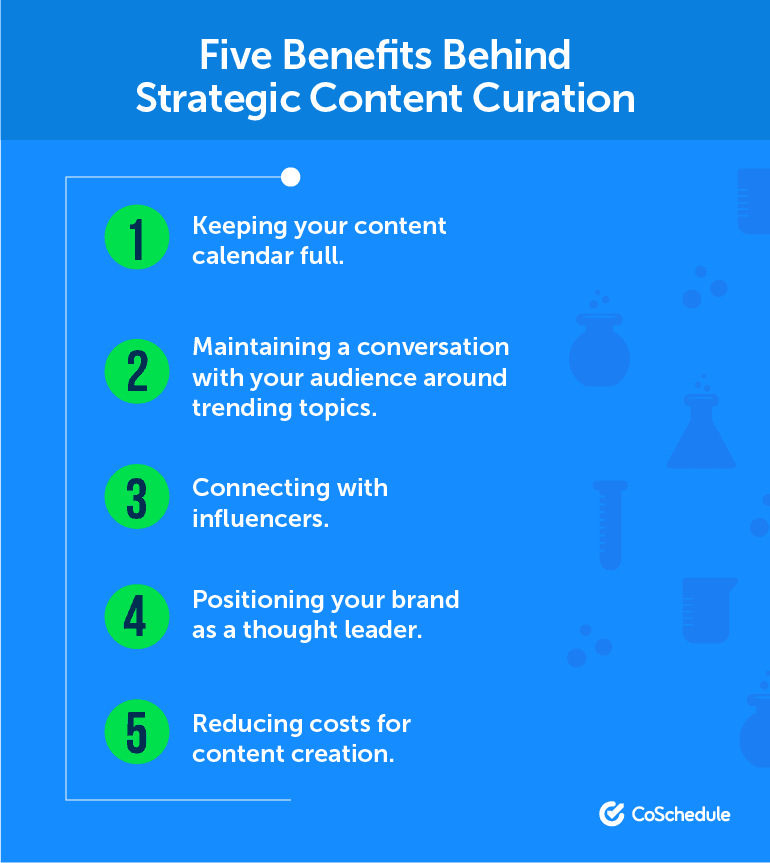 Back to the Top
Back to the Top
7 Examples of Quality Curated Content
So, what does quality social media content curation look like? Get an idea with these seven examples. Every one of these posts does the following things:- Shares something from a reputable source.
- Adds its own perspective with custom post copy.
- Adds value for each brand's audience.
#1. Convince and Convert

#2. RealTruck.com

#3. Passion Planner

#4. Cambria Quartz

#5. Buzzfeed

#6. Lemonly

#7. Sanford Health

Assembling Your Content Curation Toolbox
Now that we've covered how awesome and beneficial content curation is, it's time to implement it into your own strategy. First off, you'll need to locate and find curation worth sharing. It's one thing to share content, but it's another thing to share good content. So where do you find this magical content?- RSS readers. Gather the RSS feeds of content you know your audience will consistently enjoy. Categorize them tightly into narrowly focused topical groupings so you can better plan on the topics you’ll share when the planning stage comes. A tool like Feedly works well for this.
- BuzzSumo: This powerful platform is excellent for surfacing highly shared and trending content.
- Google Alerts. Sign up for Google Alerts on topics your readers care about. Be cautious about two things: 1) make your search as narrow as possible, or you’ll regret the flood of information, and 2) read the content you find since it’s a bit of a wild card what Google will dig up for you. You can send these alerts directly to your email.
- Focused social network lists. Create Twitter lists of people who belong in particular niches. Having all of the users in your general news feed isn’t helpful if you're trying to curate according to topic when it comes time to plan. Just as you want to categorize your RSS feeds, you ought to do the same with your social feeds.
- Forums and groups. Places like Inbound.org and other similar industry or niche related forums are perfect places to find currently hot content. Look to curate content that is getting a lot of discussion on it. Pieces that die in silence without much reaction can be seen as being down-voted by the crowd. That kind of content is probably not something your audience is going to want to read and talk about, either.
- Sign up for emails. Find great email newsletters that consistently share content you might not otherwise find. They’re doing curation of their own, and there’s nothing stopping you from making use of their finds. Just be sure to check them out to be sure it’s something your audience would want. Don’t assume just because someone else gave it a seal of approval.
Know What And How To Curate
You can’t share junk. No one wants their social feed filled with garbage, so simply publishing posts for the sake of needing to do it is a bad idea.
Find the best content, the content you enjoyed, the content your audience members are sharing and talking about, the content that is actually helpful.
No one wants their social feed filled with garbage, so simply publishing posts for the sake of needing to do it is a bad idea.
Find the best content, the content you enjoyed, the content your audience members are sharing and talking about, the content that is actually helpful.
Curate and share only the best content your audience is talking about that is actually helpful.
Click To TweetCuration keeps your social schedule fresh and promotional social messages to a minimum.
Click To TweetStart By Finding Your Content Core
As a content curator, it's your goal to share content that your audience will enjoy and benefit from. The purpose of the content core exercise is to understand the difference between what you do, and what you need to talk about. Visually, the content core looks something like this: At the center of your content is what you do.
At CoSchedule, we make editorial calendar software, so this is a combination of social media and content marketing topics. For our customers, we solve problems such as:
At the center of your content is what you do.
At CoSchedule, we make editorial calendar software, so this is a combination of social media and content marketing topics. For our customers, we solve problems such as:
- Providing a single interface for planning and executing content marketing efforts.
- Displaying an upcoming publishing schedule on a visualized monthly calendar.
- Allowing users to reschedule content via simple drag-and-drop.
- Facilitating team communication and an effective workflow.
- Providing a tool that helps them save time and grow their blog traffic.
- Reputable publications in your industry.
- Blogs from other companies you partner with.
- Your clients, if you're an agency or consultant.
Are you curating content from the best possible sources?
Click To TweetIdentify What Types Of Content Your Audience Likes To See
Does your audience prefer videos or blog posts? How about quizzes or polls? Identify what resonates with your audience and try to curate your content types around that. But how do I know what my audience likes? Look back no more than six months into your social news feed history. Look for trends in what you’re audience responded to. If you see a 35% increase in engagement when you post videos, focus on curating video content posts. Look to your audience, they’ll tell you what they want to see.Curating content? Ask your audience what they want to see.
Click To TweetMake Sure The Content You Post Is From A Reputable Source
This can't be stressed enough. Any content that you curate needs to come from a reputable source. No one wants to read poor, boring, or inaccurate content. So, no matter what industry you’re in, check your sources. A great way to check and see if your content is coming from a reputable source is the MozBar plugin for Chrome. The browser extension will score the website’s Domain Authority, giving you a better idea if the site you are on is a reputable one. The higher the score, the better, although sometimes new sites will have low scores (until they have time to build authoritativeness).
Make Sure The Content You Curate Matches Your Brand Standards
Ask yourself the following before you schedule an article:- Did the author clearly answer the posed question?
- Can I write my own unique and compelling social message to complement this content?
- Was the content easy to read and follow?
Create a Content Curation Workflow
To create a solid workflow with curation you'll need to get set-up with a few tools. Here at CoSchedule we primarily use BuzzSumo and Feedly, but be sure to test different tools to find what work best for you. Feedly is one of the most popular tools for content curation. It allows you to sort, aggregate and classify information from hundreds of sources. With Feedly, you can find content and organize it with categories. I've personally created categories such as blogging, content marketing, and social media. This way when I find multiple pieces of content, they can be organized more efficiently.
It's easy to get started with Feedly:
I've personally created categories such as blogging, content marketing, and social media. This way when I find multiple pieces of content, they can be organized more efficiently.
It's easy to get started with Feedly:
- Set up an account on Feedly.
- Use the search box to find topics you’re interested in. Feedly will provide a list of websites or blogs related to your search.
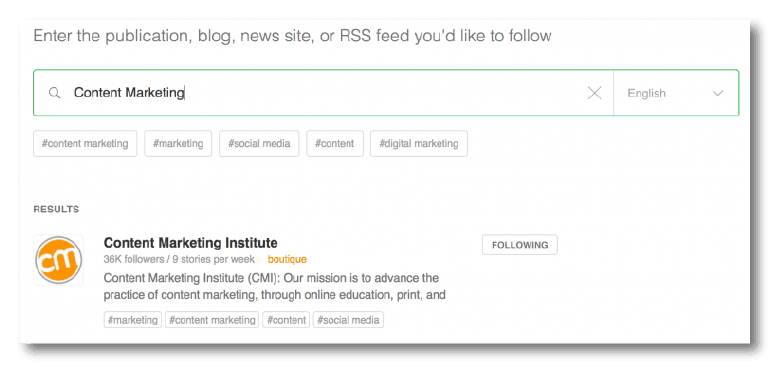
- Click on a site you want to follow. The right side of the page shows you the top stories from that site so you can see if you really want to follow it.

- If the site is what you’re looking for, click the Follow button. The Add a New Source sidebar slides out.
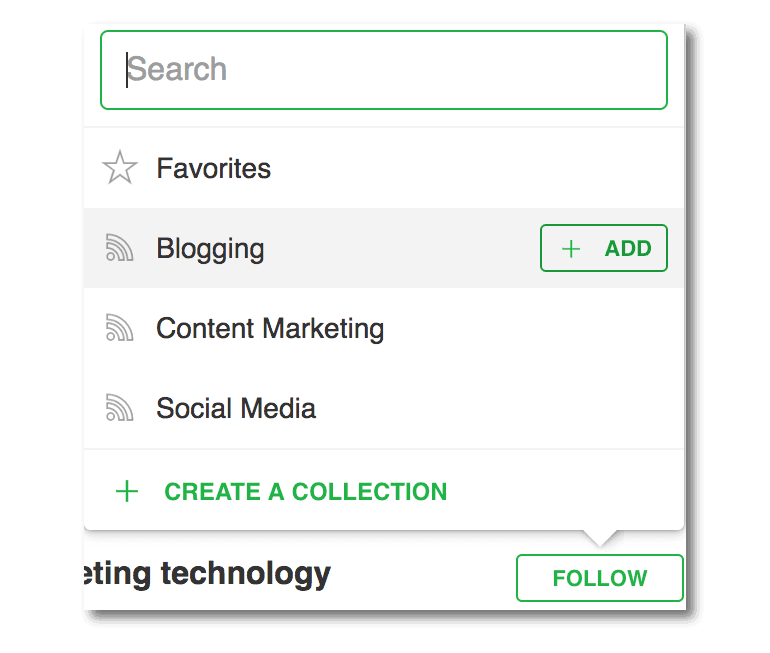
- Give the website a category (you can create your own) and click Add.
Buzzsumo
BuzzSumo is a bit different kind of tool than Feedly. One thing they both have in common, though? They're great for doing content curation. Unlike Feedly, Buzzsumo has social integrations that allow users to see how often articles have been shared across social sites. So, say I wanted to look up the latest blog posts on content marketing. Type your query into the search bar: From there BuzzSumo will start to filter in results based on the keywords you used.
You can filter content in a variety of ways including content type, date published language and domains.
From there BuzzSumo will start to filter in results based on the keywords you used.
You can filter content in a variety of ways including content type, date published language and domains.
 Now let’s say I found this great article from Convince and Convert. I read it through and realize it would be great for my followers.
But I don’t have time to send my social messages.
You can save the article for later by clicking the save button:
Now let’s say I found this great article from Convince and Convert. I read it through and realize it would be great for my followers.
But I don’t have time to send my social messages.
You can save the article for later by clicking the save button:

CoSchedule Chrome Extension
If you’re a CoSchedule user, you’ve got one more option to help you curate content for your social media channels. The CoSchedule Chrome Extension. This tool will let you schedule your content right into your marketing calendar. No longer will you have to have 17 tabs open on your computer trying to keep track of where you put one article. Nor will you have to worry about if one day is overscheduled on one social channel. Instead, you can see everything all in one place: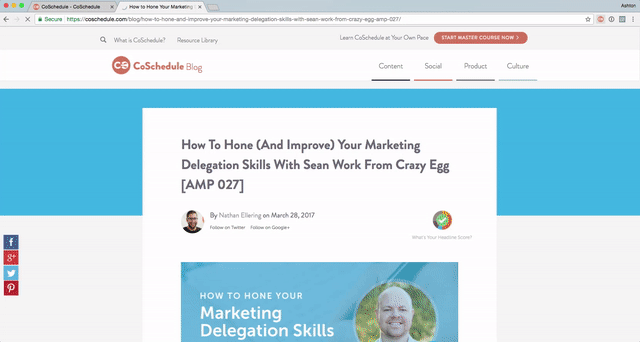 When you’re using the chrome extension, there are a few things we would suggest doing to help organize your content even more.
When you’re using the chrome extension, there are a few things we would suggest doing to help organize your content even more.
- Use the color codes to identify where your curated content is:
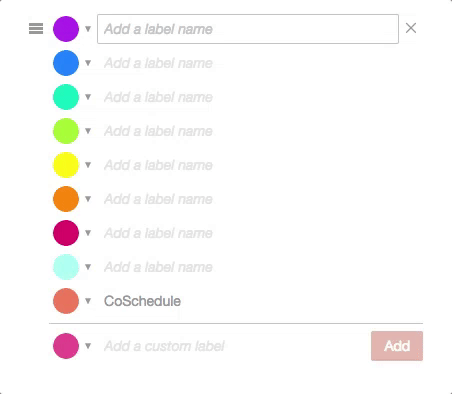
- Utilize ReQueue. It makes it easy to reshare evergreen content automatically and get even more life out of what you curate:
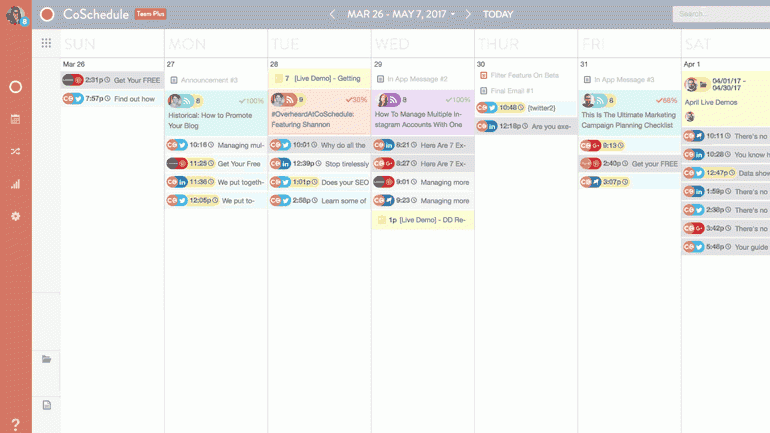
- In your saved views, set up a curated content view for easy click to view layout of when your content is publishing.


Know The Best Mix Of Curated Content
Here’s the big question most content marketers have:How much of my social media content should be curated, and how much should be my own?Kevan Lee from Buffer did a fantastic job of digging up some great recipes:
The 5-3-2 Recipe
Back in 2011, TA McCann recommended his own personal rule for social curation. It’s a proportionally based recipe, so you would keep the proportions the same when planning, whether you’re going daily or weekly.- Five pieces of content are from others.
- Three pieces of content are from you.
- Two pieces of content are from you, and are personal.
 What I like about the 5-3-2 approach is that last bit, though, the inclusion of something personal. The 5-3 content pieces are all relevant to your niche and to your audience, but by including the 2, you personalize your brand to your audience and make them care about you.
You’re not just a content machine; you’re a personal being.
What I like about the 5-3-2 approach is that last bit, though, the inclusion of something personal. The 5-3 content pieces are all relevant to your niche and to your audience, but by including the 2, you personalize your brand to your audience and make them care about you.
You’re not just a content machine; you’re a personal being.
The 4-1-1 Recipe
This mixture (from content marketers Andrew Davis and Joe Pulizzi), mentioned by Shai Coggins, is based on the idea that you have to take it easy on self-promotion, and that self-promotion has to be heavily outweighed. However, it is rather light on content creation, proportionally speaking.- Four pieces of original content of your own.
- One piece of self-serving content of your own.
- One piece of curated content.
 This one is tricky, as Coggins points out. You have to be sure you have a clear line between self-serving and non-self-serving content that you create.
Instead of the five-to-five recipe above, it’s a five-to-one recipe, and that isn’t going to provide much in terms of benefits (e.g. not enough time to create lots of original content, new networking opportunities, etc.).
This one is tricky, as Coggins points out. You have to be sure you have a clear line between self-serving and non-self-serving content that you create.
Instead of the five-to-five recipe above, it’s a five-to-one recipe, and that isn’t going to provide much in terms of benefits (e.g. not enough time to create lots of original content, new networking opportunities, etc.).
The 5-5-5+ Recipe
Coggins recommends a different recipe than the 4-1-1 approach.- Five pieces of your own content.
- Five pieces of curated content.
- Five replies or efforts at engagement.
- + is for all of the likes, #FollowFriday, and so on that you do on social media.
 While you can’t exactly plan social media engagement on your marketing calendar, you can make it part of a daily habit. I like that Coggins added engagement to the mix because it really is a part of the entire social media kingdom.
In Coggins’ recipe, it’s less about the ration (basically one-for-one) and more about making sure you have all the components in the mix (yours, others, engagement).
While you can’t exactly plan social media engagement on your marketing calendar, you can make it part of a daily habit. I like that Coggins added engagement to the mix because it really is a part of the entire social media kingdom.
In Coggins’ recipe, it’s less about the ration (basically one-for-one) and more about making sure you have all the components in the mix (yours, others, engagement).
The Rule Of Thirds Recipe
On the Hootsuite blog, the rule of thirds is posited as a viable approach. Like the 5-5-5+ approach, it’s less about ratio and more about components.- ⅓ pieces are your own content.
- ⅓ pieces are curated content.
- ⅓ pieces are based on engagement and personal interactions.

The Golden Ratio Recipe
The Rallyverse blog has a different take on social media curation.- 30% is your own content.
- 60% is curated content.
- 10% is promotional content.

The Buffer Recipe
Buffer uses a simple approach when it comes to social content curation.- 90% your own.
- 10% from others.

The 20-1 Recipe
Well-known blogger Michael Hyatt doesn’t follow a specific approach to the T, but he instead follows a philosophy that places generosity and helpfulness before everything else. Hyatt sees content marketing as a kind of relationship bank, and his recipe draws on that analogy.- 20 relational deposits.
- 1 marketing withdrawal.
 Hyatt admits he doesn’t have the data to back up his approach, but instead finds it is a guideline.
Not written in stone, of course.
As mentioned in the Buffer recipe, your approach will depend on how established you are as a content marketer, as well as what you want to achieve.
Hyatt is clearly well established, yet he wants to maintain a relational approach to people. If you are less established, it’s important to share and participate, in a higher degree, with the content of others. It’s how you get noticed.
Once you are established, you may want to start exhibiting authority by sharing more of your own content.
One key element, though, can be found in all of these recipes: Hardcore marketing and promotional social messages should be the lowest amount in any recipe you ultimately use.
Hyatt admits he doesn’t have the data to back up his approach, but instead finds it is a guideline.
Not written in stone, of course.
As mentioned in the Buffer recipe, your approach will depend on how established you are as a content marketer, as well as what you want to achieve.
Hyatt is clearly well established, yet he wants to maintain a relational approach to people. If you are less established, it’s important to share and participate, in a higher degree, with the content of others. It’s how you get noticed.
Once you are established, you may want to start exhibiting authority by sharing more of your own content.
One key element, though, can be found in all of these recipes: Hardcore marketing and promotional social messages should be the lowest amount in any recipe you ultimately use.

One Important Last Thing: Make Sure You Curate Instead Of Steal
Content curation without proper attribution and a link to the original content is theft. Content curation is not where you get your content or try to pass of large chunks of content as your own. If that’s the approach you take, you’re doing it wrong.Now Let's Get You Curating Content The Proper Way
Hopefully by now, you've de-assumed some of your assumptions around curation. Now it's all about proper implementation. Follow these tips to make the most out of your content curation strategy:- Provide your take on things by giving every curated piece some context. Whether it's through commentary, quoting, or abstracting, you should always surround the content with your views, knowledge, and insight.
- Keep a healthy mix of curated and original content. To distinguish your brand from just another content aggregator, you should inject custom content that's personal and customized to your audience. Take all the learnings from your most popular curated pieces and build off of it. Surround your own created content with reputable third-party content that are aligned with your points, tone, and opinions.
- Don't make it all about you. Avoid being you-centric with curation. It would be very easy to populate your hub with glowing reviews and articles about your business, but that would kind of be like Stephen King creating an Amazon List of the best horror novels and only including his books.
- Answer your audience's common questions about your space. Curation is an effective way to address your potential customers' inquiries or concerns through validated, third-party content. Once you've identified these FAQs, start sharing pieces that shed light on these topics to further instill your expertise in the area.
- Be very, very selective. You're trying to showcase your unique taste through these curated pieces. Pick only high-quality content that speaks toward how you'd like to be perceived.
- Always attribute your sources. Obviously, if you don't give proper credit to the original content creator, you're entering the danger zone known as plagiarism. Always attribute who produced the content, and let them know! More often than not, they'll be happy to share the post, expanding your reach and views.
- Take advantage of in-house expertise. Curation isn't just for the marketing team. No matter which department, everyone in your organization is constantly coming across interesting articles in and around your space. Create an internal culture of curating and knowledge-sharing.
- Build a hub for your curated content. In order to capture your audience on your own domain and have them coming back to you for more, you should always set up a content hub before sharing on social or any other distribution channel.
- Don't forget about CTAs! Make sure that your content is outfitted with appropriate calls to action. Whether it's signing up for a newsletter, requesting a demo, downloading an asset, or even a link to another piece of content, give your audience something to do once they've consumed your content.
Invest In Your Success: Become A Certified Social Media Strategist
Want to learn more best practices for social media? Look no further. Actionable Marketing Institute has a Social Media Strategy Certification course designed to help you drive more traffic, leads, & growth from your social media strategy.
Back to the Top
Portions of this blog post were originally written by Erica Kim, Breonna Bergstrom, Halle Klingman, and Julie Neidlinger. This content was most recently compiled and updated on Jun. 20, 2018.
Actionable Marketing Institute has a Social Media Strategy Certification course designed to help you drive more traffic, leads, & growth from your social media strategy.
Back to the Top
Portions of this blog post were originally written by Erica Kim, Breonna Bergstrom, Halle Klingman, and Julie Neidlinger. This content was most recently compiled and updated on Jun. 20, 2018.

